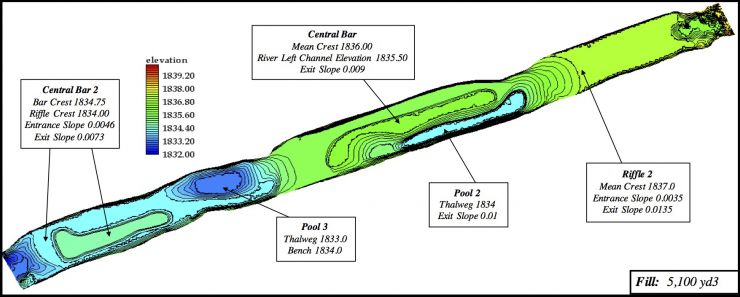TR Design 6
Concept
Design 6 continued the evolution of the blanket-fill concept from Design 5 by significantly increasing the sizes and amending the shapes of the second and third riffles, which resulted in a lower overall bed slope. This design had a slightly lower riffle-pool relief (0.74m) as Design 5, but it had the lowest asymmetry of all designs (0.89). As in Designs 4 and 5, the river right was widened 3 m to remove encroached vegetation and increase the area of low-velocity fry habitat along the bank. Channel slope was the same 0.17% as in Design 4, which was significantly lower than that for Design 5. However, riffle-pool relief was closer to that for Design 5, yielding a blend of design concepts. The second riffle in Design 6 was amended relative to Design 5 by adding a long riffle at the end of the central bar and adding a hook to the end of the bar to reduce potential scour resulting from flow convergence at the exit of the pool flanking the bar on river left. The bar crest was set 0.15 m higher than the slow glide on the right and 0.61 m feet higher than the chute-pool unit on the left. Moreover, the central bar was elongated and the pool shape adjusted to maximize the hydraulic and habitat benefits of the chute-pool unit. The riffle exit slope was graded concave at 2% to focus the majority of the flow into the downstream pool and a small portion along the river right. Downstream of the central bar, the existing pool thalweg was shifted to river right to drive flow to cross-over to river right. This smaller pool was also constricted with a lateral bar on the left that links the riffles with a slow-glide feature that could serve for rearing. Unlike the first central bar, the second one has a much wider primary path on river right and a narrow secondary path on river left; these serve the same functions explained for the central bar in Design Five, just with a different flow split. The exit slope of the last riffle was graded convexly to cause flow divergence instead of convergence, and thus reduce scour on the tail end of the feature in the thalweg. By making the riffle longest in the middle, it has the most resilience against headcutting (associated with the “reverse domino” riffle sequence collapse mechanism described by Pasternack et al., 2008); headcutting along the flanks is less effective, because of less flow and high bank roughness there. Design Six was estimated to require uses 3,889 m3 of gravel and cobble.
Design Map

Design Hypotheses
| Attributes | Riffle 2 | Central Bar/Pool 2 | Pool 3 | Central Bar 2 |
| Hydraulic | Existing riffle widened to promote flow divergence. Preceding pool exit slope graded to gradually dissipate high velocities. |
Majority of flow will be through pool 2. Divergent flow fields around bar, convergence on side channels, focused in deeper channel on river right depressions. “L-shaped “bar feature forces flow divergence over bar face. |
Constrictions at pool entrance and pool exit will induce flow convergence, flow acceleration, and eddy formation adjacent to banks. Bench morphology on river right for spawning. |
Flow splits at bar face with majority focused in wider chute on river right. “L-shaped “bar feature minimizes scour and forces flow divergence over bar face. |
| Geomorphic | Flow divergence will cause deposition along pool exit to riffle crest. |
Majority of flow will be through pool 2. Pool 2 will serve as a trap for upstream sediments to keep them in the reach for continued spawning use. “L-shaped “bar feature minimizes scour and forces flow divergence over bar face causing deposition from preceding chute. |
Existing thalweg is shifted to the river left to maintain thalweg on river left through the downstream feature. Constricted pool is conducive to pool maintenance. |
“L-shaped “bar feature minimizes scour and forces flow divergence over bar face causing deposition from preceding chute. Convex exit slope will minimize scour by causing flow divergence instead of convergence. |
| Fisheries | -Spawning on river right of riffle and on riffle crest and pool exit slope. -Increased fry habitat along river right banks along riffle crest and riffle exit. |
-Spawning on pool exit slopes and on bar top. -Fry habitat on river right channel margin. -Adult holding in depressions. |
-Adult holding habitat in pool. -Fry habitat created over channel constriction features and on river left in areas where channel was widened. -Spawning on peripheral pool benches. |
-Spawning on entire riffle and entrance and exit slope. |
Design Testing with FESWMS 2D Model
System response was evaluated in terms of flow pattern, fish habitat quality, and sediment transport regime at three discharges within the regulated range permitted by operational rules at the time. At the links below, the results are shown for two of those discharges: (1) a typical baseflow (300 cfs) present during most of the year when fish are spawning and embryos are incubating and (2) the peak regulated flood discharge released by the dam at that time (6000 cfs).
Click links below to see model results:


